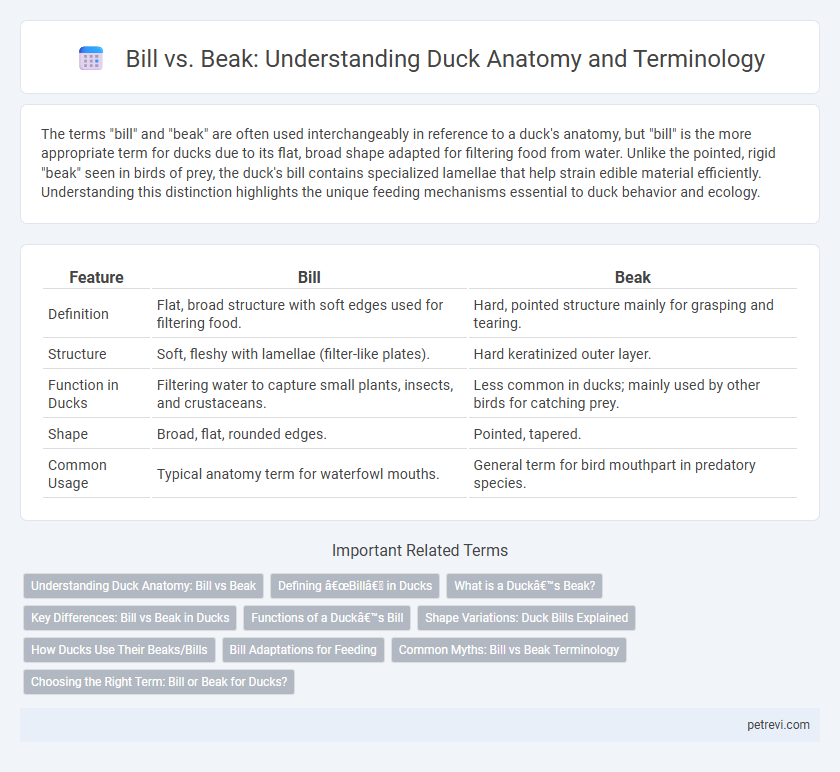The terms "bill" and "beak" are often used interchangeably in reference to a duck's anatomy, but "bill" is the more appropriate term for ducks due to its flat, broad shape adapted for filtering food from water. Unlike the pointed, rigid "beak" seen in birds of prey, the duck's bill contains specialized lamellae that help strain edible material efficiently. Understanding this distinction highlights the unique feeding mechanisms essential to duck behavior and ecology.
Table of Comparison
| Feature | Bill | Beak |
|---|---|---|
| Definition | Flat, broad structure with soft edges used for filtering food. | Hard, pointed structure mainly for grasping and tearing. |
| Structure | Soft, fleshy with lamellae (filter-like plates). | Hard keratinized outer layer. |
| Function in Ducks | Filtering water to capture small plants, insects, and crustaceans. | Less common in ducks; mainly used by other birds for catching prey. |
| Shape | Broad, flat, rounded edges. | Pointed, tapered. |
| Common Usage | Typical anatomy term for waterfowl mouths. | General term for bird mouthpart in predatory species. |
Understanding Duck Anatomy: Bill vs Beak
The terms "bill" and "beak" both refer to the specialized structure on a duck's face, though "bill" is more commonly used in waterfowl like ducks. Ducks' bills are broad, flat, and equipped with lamellae that act like a sieve to filter food from water, distinguishing them from the pointed beaks of predatory birds. Understanding this anatomical difference is crucial for identifying feeding habits and ecological adaptations in various duck species.
Defining “Bill” in Ducks
The bill of a duck is a broad, flattened structure at the front of its face used for feeding, filtering, and sensing the environment. Unlike a typical bird's beak, the duck's bill contains specialized lamellae that aid in straining food from water and mud. This adaptation allows ducks to efficiently capture aquatic plants, insects, and small fish crucial for their diet and survival.
What is a Duck’s Beak?
A duck's beak is a specialized, flat, and broad structure used primarily for feeding and grooming, composed of keratin and supported by bone. Unlike a bill, which refers more generally to the hard, pointed mouthpart of birds, a duck's beak often contains lamellae--fine, comb-like structures that help filter food from water. This adaptation allows ducks to efficiently forage for aquatic plants, insects, and small fish in their natural habitats.
Key Differences: Bill vs Beak in Ducks
The primary difference between a duck's bill and beak lies in their functional structure and terminology, where the bill typically refers to the broader, flat, and often flexible structure used for filtering food, while the beak primarily denotes the hard, pointed tip. Duck bills are equipped with lamellae, comb-like structures aiding in straining food from water, which is less commonly emphasized in the term "beak." Understanding these distinctions enhances clarity in avian anatomy discussions and highlights adaptive traits unique to ducks.
Functions of a Duck’s Bill
A duck's bill is specialized for filtering food from water, equipped with lamellae that act like sieves to trap small plants, insects, and crustaceans. Unlike a beak designed primarily for grasping or tearing, the bill facilitates efficient foraging in aquatic environments by allowing ducks to strain nutritious particles from mud and water. This adaptation enhances a duck's ability to exploit diverse food sources vital for its survival and energy intake.
Shape Variations: Duck Bills Explained
Duck bills exhibit a wide range of shape variations tailored to their feeding habits and habitats, with some species having broad, flat bills for filtering water and others sporting narrow, pointed bills for catching fish. The lamellae, comb-like structures along the edges of many duck bills, assist in straining food from water, showcasing functional adaptations in bill design. Variations in bill shape also impact swimming and foraging efficiency, making the morphology of duck bills a critical factor in species identification and ecological niche specialization.
How Ducks Use Their Beaks/Bills
Ducks use their bills to forage and filter food from water, equipped with specialized lamellae that act like a sieve. The bill's sensitive tip helps detect small insects, plants, and crustaceans, while its shape varies according to their diet and habitat. Unlike other birds, a duck's bill aids both in feeding and thermoregulation by releasing excess heat.
Bill Adaptations for Feeding
Duck bills exhibit specialized adaptations that enhance feeding efficiency in varied aquatic environments. The lamellae, comb-like structures along the edges of the bill, function as sieves for filtering small invertebrates and plant material from water. Additionally, the shape and sensitivity of the bill allow ducks to detect and grasp food items with precision, optimizing nutrient intake.
Common Myths: Bill vs Beak Terminology
The terms "bill" and "beak" are often used interchangeably in duck anatomy but have subtle distinctions based on usage and context. "Bill" generally refers to the broader, flatter mouthpart adapted for dabbling and filtering food in water, which is characteristic of ducks. Scientific literature favors "bill" for waterfowl, while "beak" is more commonly used for predatory birds like raptors, reflecting differences in shape and function.
Choosing the Right Term: Bill or Beak for Ducks?
The term "bill" is preferred over "beak" when referring to ducks, as "bill" specifically describes the broad, flat, and soft structure adapted for dabbling and filtering food in water. In contrast, "beak" generally applies to birds with pointed and hard structures used for pecking or gripping. Using "bill" for ducks aligns with ornithological terminology and accurately reflects their feeding behavior and anatomical adaptations.
Bill vs Beak for Duck Anatomy Infographic

 petrevi.com
petrevi.com